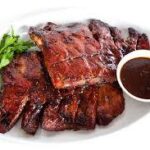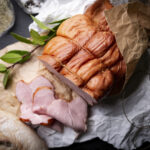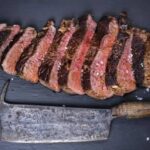Making Beef Biltong at Home in Canning Vale
A love for gourmet cuisine inspired the creation of beef biltong in Canning Vale. The idea was born from a need for a high-quality on-the-go snack backed by a light-hearted, approachable brand. Because of this, we set out to create a nutritious snack that was true to the original beef flavour. Bareback Biltong stands out because, although being made from other types of meat, it tastes just like beef because of its delicate texture and savoury blend of spices.
How To Prepare Beef Biltong At Home In Canning Vale?
Even though making biltong, a type of South African dried meat and cured beef, is a simple operation, it takes a long time. To achieve ideal marination, the meat must be cleaned, hung in a drying facility at 40-60 degrees Celsius (104-140 degrees Fahrenheit) for four to six days, cured for 24 hours (turned at the 12-hour mark), seasoned, and cooked. After cooking, the beef is chopped into bite-sized pieces and served.
Ingredients
- 1 kg of beef top round (capped or uncapped)
- Brown vinegar, 200 ml
- Two tablespoons salt
- Pepper, about two tablespoons
- One teaspoon of powdered garlic
- One Tablespoon of Paprika
- One tablespoon of ground or shaved nutmeg
- Coriander, one tablespoon
Method:
- Step 1: Cut the topside steak into strips that are 25 millimetres wide, then marinate the meat in brown vinegar and store it in a Tupperware container.
- Step 2: Cover the container in the refrigerator for 24 hours, turning once after 12 hours.
- Step 3: Mix the spices and herbs in a bowl.
- Step 4: Get the beef out of the fridge and let it sit in a marinade of your choice.
- Step 5: Set aside four to six days to dry the beef after marinating it. When you want your biltong to be done depends on how wet you want it.
- Step 6: Cut the dried, cured beef into slices when the moisture level is right. The story of doneness is a matter of personal opinion, but the meat should be firm throughout, with no slack where the fork can’t go in easily and a noticeable spring when released.
- Step 7: Always keep your biltong in an airtight glass container in a cold, dry area.
Origins:
The Dutch words for “buttock” (“bil”) and “tongue” (or “strip”) were combined to get the English expression “biltong.” In the days before refrigerators, pioneers had to get creative to keep their meat fresh. To achieve this, they cured or dried their meat. Because of this, biltong shops were often fashioned from anything a hunter could capture. In addition, it was usually produced in the winter, when colder temperatures lowered the likelihood of mould growth.
Excellent Choice for Biltong:
Because beef is readily available at any grocery store or butcher shop, it will be used in this dish.
You should start using some meat from hunting adventures once you’ve mastered creating biltong. The most common types of biltong are those made from beef and venison. Deer biltong is fantastic if you prefer your meat on the drier side. Fattier cuts of beef might be more difficult to dry without rotting, so it’s best to steer clear of those if possible. Instead of buying pricey cuts of meat for preparing biltong, spend that money on grilling high-quality steaks like fillets.
The drying process causes part of the weight to be lost, so that biltong can be very pricey per pound, but it is well worth it! It would help if you trimmed the fat after you’ve decided on a cut, most likely silverside or topside. It would help if you also trimmed the biltong of any gristle or sinew that might make the snack unappealing once dried. Many do not prefer making this dried meat at home and hence, order their favourite biltong online or from nearby biltong shops.
Important Facts About Dehydrating Biltong
Air drying the biltong takes longer and requires favourable weather conditions. In contrast, a commercial biltong maker or dehydrator has a built-in fan for continuous airflow to speed up the process, as well as a light fitting that prevents the formation of mold, and also helps reduce moisture. If you don’t have access to an electric dryer but want to dry your meat quickly, you can purchase air-drying nets and point a fan at heart. As the deterioration of beef is more likely in humid conditions, biltong is best made in the drier and cooler seasons of the year. If you weren’t aware, beef biltong in Canning Vale is air-dried rather than smoked.
Pay Attention to Mold:
- If your biltong has mold on it, throw it away immediately. A consumer felt the biltong he had forgotten in the fridge for a while would be fine if he only removed the small rotten piece from the middle. His better half flat-out refused to partake.
- His wife called an ambulance after he fainted later that night from vomiting and diarrhoea. He was brought to the hospital and spent ten days in critical care before being released.
- Even if mold only seems to be on the surface of a meal, its threadlike spores may have already colonised deeper within.
- Everyone who is any good at making biltong has their secret recipe.
It takes only a little time and patience to make this delicious biltong. Biltong is a tasty dried beef snack that can be made in large quantities. The difficult part is doing it.







